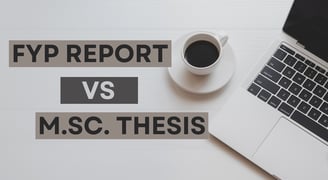When students start their academic careers, particularly in the field of research and academia, they frequently come across two key milestones: preparing a Final Year Project (FYP) report at Bachelor’s level and writing a Master's thesis at Master’s level. Despite their connections, these two endeavors have core differences that define their nature and goals. Comprehending these differences is essential for students who want to succeed in their academic pursuits.
Understanding the Final Year Project Report (FYP)
Definition and Purpose
A Final Year Project (FYP) report typically encapsulates the culmination of a student's undergraduate studies. It serves as a demonstration of theoretical knowledge and practical application acquired during the course or project.
Scope and Requirements
FYP reports are often structured around specific guidelines set by the educational institution. They generally cover a narrow scope of research, requiring a comprehensive yet concise analysis of the chosen topic or the developed project.
Supervision and Execution
Under the guidance of a mentor or supervisor, FYP reports are executed within a stipulated time frame, focusing on problem-solving and practical application.
Insights into a Master's Thesis
Defining a Master's Thesis
A master's thesis, on the other hand, shows a greater level of proficiency in research methodology and analysis while delving deeper into a chosen subject. It represents the apex of a graduate program.
Depth of Research and Analysis
A master's thesis requires in-depth study, exploring the nuances of the topic with an emphasis on making an original contribution to the field.
Original Contribution and Rigor
Unlike FYP reports, theses emphasize originality, often requiring innovative ideas and rigorous analysis backed by scholarly literature.
Key Differences
Length and Depth
One of the primary distinctions lies in the length and depth of exploration. Master's theses tend to be longer and more exhaustive in their exploration compared to FYP reports.
Originality and Innovation
While both require thorough analysis, research theses demand a higher level of originality, encouraging students to contribute innovative perspectives to existing knowledge.
Evaluation and Examination Criteria
Evaluation criteria for FYP reports are often centered on practical application and demonstration of learned concepts, whereas theses are assessed based on original research, depth of analysis, and academic contribution.
Guidelines for Writing
FYP Report Writing Tips
Focus on clarity and conciseness
Emphasize practical implications
Align with provided guidelines
Master's Thesis Writing Tips
Conduct an exhaustive literature review
Highlight original contribution
Maintain academic rigor and citation standards
Significance of Each
Academic Contribution
FYP reports signify the culmination of undergraduate studies, showcasing applied knowledge, whereas Master's theses represent a higher level of scholarly contribution, often setting the stage for further academic pursuits.
Professional Relevance
While FYP reports demonstrate practical application, Master's theses hold weight in academia, contributing to scholarly discourse and potentially influencing future research.
Challenges and Overcoming Them
Common Challenges in Writing
Students often encounter challenges in structuring their arguments, balancing depth with clarity, and meeting the required standards of academic writing.
Strategies to Overcome
Engaging with mentors, conducting extensive research, and dedicating ample time for revisions are crucial strategies in surmounting these challenges.
Understanding Audience and Purpose
Target Audience Differences
FYP reports often cater to a more general audience within the educational institution, whereas theses are aimed at contributing to academic literature, targeting scholars and researchers in the field.
Varied Objectives
While both serve educational objectives, the FYP report aims to demonstrate practical learning, whereas the Master's thesis aims at advancing scholarly knowledge.
A master's thesis and a final-year project report are essentially different in terms of their depth, scope, originality, and intended contribution. Although they both represent important turning points in a student's academic career, they serve diverse functions, influencing the educational process and making unique contributions to the academic environment.




